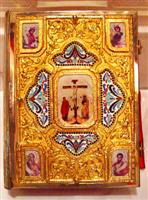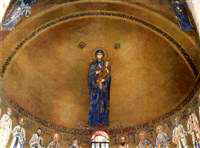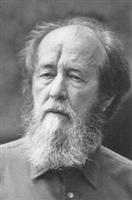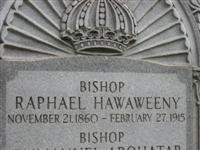
I used to keep a Yoda action figure on the shelf above my computer desk. It reminded me of the wise sayings Yoda imparted to Luke during his Jedi training in the swamps of Degobah. One of my favorite sayings in
The Empire Strikes Back is Yoda's instruction to Luke, “You must unlearn what you have learned.”
Those who desire to become Orthodox Christians begin their spiritual journey into the Church and its way of life as
catechumens, those who are being instructed in the Faith. During their time of preparation catechumens experience a process both of learning and unlearning. By unlearning, I don’t just mean unlearning particular ideas, but also unlearning one’s entire concept of reality and way of thinking. It’s learning by experience. The Orthodox Christian way of life can’t be just learned by taking classes and reading books. It is learned by immersing oneself into the spiritual way of life as much as possible in the midst of the Church. Our way of life is absorbed by participating in it. As one gradually learns the Faith as a catechumen he or she must shed prior misconceptions about spirituality, the self, God, relationships, life, and the world.
Secular people who consider themselves “spiritual, but not religious” must unlearn what American culture has taught them about reality. That’s not easy. The culture continuously reinforces its constantly evolving teachings. Every time we watch popular TV, read the news on the internet, see an advertisement in a magazine, or talk with friends who are themselves influenced by secular culture we receive a lesson from the culture about what we are supposed to think and how we are supposed to live. Sometimes seculars have been influenced by religious traditions such as Buddhism, Hinduism, and Paganism. If these worldviews and belief systems are not unlearned then the person may consciously or unconsciously blend together Orthodox Christianity with an incompatible and contradictory way of life. This results in confusion. To develop an Orthodox Christian ways of thinking, feeling, and living one must unlearn the the old ways in order to learn a whole new way of seeing the world and experiencing life. When a person unlearns the old ways and learns the new ways then he or she will probably be able to more clearly see the errors and omissions of the way of life left behind. On the other hand, once a person understands the Orthodox Christian way of life through experience he or she may discover that Orthodox Christianity fulfills all those positive, nurturing things attractive about the former way of life.
At seventeen years old, Marjorie Corbman wrote
A Tiny Step Away from Deepest Faith, a book about her teenage search for meaning. In her book, she described her journey to becoming an Orthodox Christian:
“I stopped being a Wiccan when I looked into the history of the religion. I stopped being a pagan because I was simply believing in my own personal fancies, my own ideas, and my God was as small as I was. I wanted something larger. I waited for a pantheon—any pantheon—to take hold of me. Any religion of old, any forgotten wisdom, any god or goddess willing to grab me. To my utter dismay, I began to feel the Christian “pantheon” drawing me in—Jesus, Mary, the Magdalene…I stuck with Gnosticism until I looked into the history of
that as well. In time I realized what ancient faith I was looking for, what religion, what Tradition, what Person. It—He—was not what I wanted. But I was looking for Truth.
My Jewish childhood prepared me for a lot of things. Of course it prepared me for traditional Christianity when I finally came to Him, as traditional Christianity comes directly out of Judaism. But above all Judaism gave me a sense of tradition—of history understood as a process of following the One True God. Ancient prayers, written for me, soaked in thousand-year-old wisdom—my childhood is full of rituals and prayers, Shabbat candles and Torah scrolls, Kiddush cups and braided bread, although none of this was explained to me very well—and this sensibility carried me through to the rest of my life until now. When I cross myself, bow, kiss my icons in the morning, and pray—
O Heavenly King, O Comforter, the Spirit of Truth who art in all places and fillest all things, the treasury of good things and Giver of Life—I sometimes remember this, where I came from. Everything I had then is not gone, but has been fulfilled—abundantly” (53-54).
Many people in America have been heavily influenced by Roman Catholicism or Protestantism. Some Americans have rejected Christianity based on their negative experience with the Roman Catholic Church or the Protestant movement (Baptist, Methodist, Presbyterian, Pentecostal, Independent, etc.) Unfortunately, when such men and women encounter Orthodox Christianity, they assume that their negative experiences with Roman Catholicism or Protestantism also relates to Orthodox Christianity. They judge Orthodox Christianity unfairly based on predjudice. In order to learn to live the Orthodox Christian Way, such individuals need to unlearn their misconceptions and false assumptions so they can see and know Christianity as it really is in its most ancient, purest, and fullest form.
People who have rejected Roman Catholicism or Protestantism aren’t the only ones who need to unlearn in order to learn. Christians outside of the Orthodox Church who are coming home to the ancient Church from Roman Catholicism and Protestantism also need to humbly unlearn the Christianity they thought they knew in order to discover the fullness of the Christian Faith in the Orthodox Christian Church. In his book,
One Flew Over the Onion Dome, Father Joseph David Huneycutt offers valuable advice for those who teach catechumens the Orthodox Christian Faith:
“Orthodox Christianity is the Church. All other manifestations of 'church' have subtracted from the Church. Having grown up in the Baptist tradition, I heard the Epistles anew, seemingly for the first time, when I became Orthodox. St. Paul was writing to the Church. And here I was, now a member of that same Body, the Church, hearing his writings in a whole new light. No longer did I have to struggle to hear the writings of St. Paul speaking to me personally. From time to time that may be the case, yet the Epistles were and are to the Church. It is a “we thing” that we take personally; it’s hard to explain to an outsider. But like all families, clarity comes within the confines of membership. There’s no other way to experience marriage and family without participating in it.
Not utilizing the whole of the canon of catechism and the Scriptures in teaching Seekers about the Faith is a mistake. It is incorrect to view all outsiders as Catechumens. Converts need to reexamine, on their own terms, previously held beliefs and assumptions about Christ, the Church, and salvation. For the Orthodox to assume that those coming to Her from other Christian backgrounds need merely to add icons, incense, and liturgical worship is an erroneous assumption. It is best to just start from scratch. “Scratch,” in this case, is that Faith which has been preserved and handed down from generation to generation in the Church” (77-78).
I generally don’t like to compare Orthodox Christianity with other faith traditions because Orthodox Christianity stands alone, witnessed by the presence of all the Saints who have lived in all ages. Sometimes, however, helping people unlearn their misconceptions means helping them understand how the Protestantism and Roman Catholicism of the Western World came out of Eastern Orthodox Christianity and developed into what they are today. I recently left a comment on a post about my experience explaining Orthodox Christianity to people in Appalachia. Here is part of the post:
“My native culture is often antagonistic toward and resistant to Roman Catholicism….One of the greatest obstacles preventing Appalachian people from opening their hearts, minds, and souls to Orthodox Christianity, once they encounter it, is that is appears too “Catholic,” meaning “Roman Catholic,” to them. I find it important for people to now about Church history. Becoming Orthodox doesn’t mean becoming Roman Catholic, but it doesn’t mean being Protestant either. Rather, becoming Orthodox involves leaving behind both Roman Catholicism and the protest against Rome to proceed deeper into ancient times to find the Apostolic Church revealed in the Bible.”
Explaining Orthodox Christianity to Protestants can be difficult, even if they know the content of the Bible. If a Protestant asks, “What is the Orthodox Church?” a simple answer may be something like this: “The Orthodox Church is the original Church, the Church founded by Jesus Christ upon His Apostles 2,000 years ago, and that has continued keeping the Faith until today.” Since the questioner has not yet begun to unlearn his or her Protestant way of understanding Christianity and hasn’t learned about the place of the Orthodox Church in history, that answer may not make sense to the person.
The conversation could turn into a discussion about particular points of doctrine. Trying to see Orthodox Christianity through a Protestant lens (or any other foreign lens) is like someone trying to see what he or she really looks like by looking into one of those odd-shaped funhouse mirrors. As a square peg doesn’t fit into a round hole, the Orthodox Christianity is incompatible with a Protestant understanding and approach to Christianity. For Protestants to understand Orthodox Christianity, they must learn Christianity all over again from the beginning. As catechumens they will learn Orthodox Christianity, the Christian way of life in its original, purest, and fullest form, the Faith that incorporates right faith and right belief in a complete spiritual way of life.
Becoming an Orthodox Christian isn’t just about unlearning incorrect information about the universe in order to become philosophically right about theological ideas. While the word Orthodox implies having “correct belief,” correctness isn’t the goal. Pride and arrogance can cause people to be so concerned with defending their right position and pointing out why others are wrong that they lose the spiritual reason that correct belief is important. Being an Orthodox Christian means knowing who God really is, who we really are, what the world is really like, and who we can really become by reaching our full potential. Knowing who we are and knowing who God is allows us to have a healthy relationship with God and mystically commune with Him. Only within a relationship with God can we spiritually grow and experience the personal healing and transformation that brilliantly restores the dust-covered divine likeness within us. In other words, Orthodox Christianity isn’t about being
right as much as it’s about becoming spiritually
good through our relationship with God.
Jesus Christ is the Truth. When Pontius Pilate asked Jesus, “What is Truth?” before sending Him to be crucified, Pilate asked the wrong question. The real question is “Who is Truth?” Truth is a person, the Son of God, the One who is truly human like us and truly God at the same time. He is God in human flesh, the embodiment of Truth, Life, and Love. Knowing the Truth isn’t about objectively having the right answers to theological questions, but it’s about having a good, intimate, beneficial relationship with Jesus Christ Himself. When we know the Truth experientially through a relationship with Him then we begin to take on His image, the shining divine image that radiates love, purity, humility, peace, patience, and wisdom. Knowing the Truth doesn’t just make us
right, it makes us
good.
Teaching catechumens the Orthodox Christian Faith means helping them unlearn misconceptions they have picked up so that they can learn the spiritual way of life without confusion. The process of unlearning is important for catechumens but it isn’t for catechumens only. All of us who are Orthodox Christians must continue to be reminded of what we believe so that we can unlearn the ideas that we pick up from cultural propaganda. Let’s continue learning the good and unlearning the bad so that we keep the Faith once and for all delivered to the saints in its fullness.
“Therefore, brothers, stand fast and hold on to the traditions that you were taught, whether by word or by our letter” (
St. Paul’s Second Letter to the Thessalonians 2.15).
Corbman, Marjorie.
A Tiny Step Away from Deepest Faith: A Teenager’s Search for Meaning. (Brewster, MA: Paraclete Press, 2005), 53-54.
Huneycutt, Father Joseph David.
One Flew Over the Onion Dome: American Orthodox Converts, Retreads, and Reverts. Salisbury, MA: Regina Orthodox Press, 2006), 77-78. Hear an interview with Father Joseph about the book on
Come Receive the Light. Also, visit Father Joseph's blog,
Orthodixie.
The image of the Holy Gospels is from
St. Philip Orthodox Christian Church in Ft. Lauderdale, FL. Used by permission.
Copyright © 2006 by Dana S. Kees.
 "Admit it - you really hate modern art": This is the title of an article recently published by The Asian Times. So much of Contemporary Art seems devoid of beauty, often influenced by the intellectual rejection of beauty as an idea.
"Admit it - you really hate modern art": This is the title of an article recently published by The Asian Times. So much of Contemporary Art seems devoid of beauty, often influenced by the intellectual rejection of beauty as an idea.










 "Rejoice, O Father Raphael, Adornment of the Holy Church! Thou art Champion of the true Faith, Seeker of the lost, Consolation of the oppressed, Father to orphans, and Friend of the poor, Peacemaker and Good Shepherd, Joy of all the Orthodox, Son of Antioch, Boast of America: Intercede with Christ God for us and for all who honor thee." - Troparion of St. Raphael
"Rejoice, O Father Raphael, Adornment of the Holy Church! Thou art Champion of the true Faith, Seeker of the lost, Consolation of the oppressed, Father to orphans, and Friend of the poor, Peacemaker and Good Shepherd, Joy of all the Orthodox, Son of Antioch, Boast of America: Intercede with Christ God for us and for all who honor thee." - Troparion of St. Raphael







